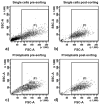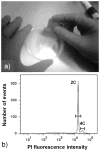Flow cytometric methods to investigate culture heterogeneities for plant metabolic engineering
- PMID: 20552456
- PMCID: PMC4283195
- DOI: 10.1007/978-1-60761-723-5_17
Flow cytometric methods to investigate culture heterogeneities for plant metabolic engineering
Abstract
Plant cell cultures provide an important method for production and supply of a variety of natural products, where conditions can be easily controlled, manipulated, and optimized. Development and optimization of plant cell culture processes require both bioprocess engineering and metabolic engineering approaches. Cultures are generally highly heterogeneous, with significant variability amongst cells in terms of growth, metabolism, and productivity of key metabolites. Taxus cultures produce the important anti-cancer agent Taxol((R)) (i.e., paclitaxel) and have demonstrated significant variability amongst cell populations in culture with regard to paclitaxel accumulation, cell cycle participation, and protein synthesis. To fully understand the link between cellular metabolism and culture behavior and to enable targeted metabolic engineering approaches, cultures need to be studied at a single cell level. This chapter describes the application of plant cell flow cytometric techniques to investigate culture heterogeneity at the single cell level, in order to optimize culture performance through targeted metabolic engineering. Flow cytometric analytical methods are described to study Taxus single cells, protoplasts, and nuclei suspensions with respect to secondary metabolite accumulation, DNA content, cell size, and complexity. Reproducible methods to isolate these single particle suspensions from aggregated Taxus cultures are discussed. Methods to stain both fixed and live cells for a variety of biological markers are provided to enable characterization of cell phenotypes. Fluorescence-activated cell sorting (FACS) methods are also presented to facilitate isolation of certain plant cell culture populations for both analysis and propagation of superior cell lines for use in bioprocesses.
Figures



Similar articles
-
Flow cytometric analysis of protein content in Taxus protoplasts and single cells as compared to aggregated suspension cultures.Plant Cell Rep. 2005 Jan;23(8):528-33. doi: 10.1007/s00299-004-0875-y. Epub 2004 Sep 22. Plant Cell Rep. 2005. PMID: 15449019
-
Statistical optimization of single-cell production from Taxus cuspidata plant cell aggregates.Prep Biochem Biotechnol. 2011;41(3):219-35. doi: 10.1080/10826068.2011.575261. Prep Biochem Biotechnol. 2011. PMID: 21660862
-
Contribution of taxane biosynthetic pathway gene expression to observed variability in paclitaxel accumulation in Taxus suspension cultures.Biotechnol J. 2012 Mar;7(3):418-27. doi: 10.1002/biot.201100183. Epub 2012 Jan 10. Biotechnol J. 2012. PMID: 22095859 Free PMC article.
-
Bioprocessing of plant in vitro systems for the mass production of pharmaceutically important metabolites: paclitaxel and its derivatives.Curr Med Chem. 2013;20(7):880-91. Curr Med Chem. 2013. PMID: 23210777 Review.
-
A rational approach to improving the biotechnological production of taxanes in plant cell cultures of Taxus spp.Biotechnol Adv. 2014 Nov 1;32(6):1157-67. doi: 10.1016/j.biotechadv.2014.03.002. Epub 2014 Mar 27. Biotechnol Adv. 2014. PMID: 24681092 Review.
Cited by
-
Recent advances towards development and commercialization of plant cell culture processes for the synthesis of biomolecules.Plant Biotechnol J. 2012 Apr;10(3):249-68. doi: 10.1111/j.1467-7652.2011.00664.x. Epub 2011 Nov 8. Plant Biotechnol J. 2012. PMID: 22059985 Free PMC article. Review.
-
Development of High-Quality Nuclei Isolation to Study Plant Root-Microbe Interaction for Single-Nuclei Transcriptomic Sequencing in Soybean.Plants (Basel). 2023 Jun 28;12(13):2466. doi: 10.3390/plants12132466. Plants (Basel). 2023. PMID: 37447027 Free PMC article.
-
Methyl jasmonate represses growth and affects cell cycle progression in cultured Taxus cells.Plant Cell Rep. 2014 Sep;33(9):1479-92. doi: 10.1007/s00299-014-1632-5. Epub 2014 May 16. Plant Cell Rep. 2014. PMID: 24832773 Free PMC article.
-
Simultaneous Evaluation of Life Cycle Dynamics between a Host Paramecium and the Endosymbionts of Paramecium bursaria Using Capillary Flow Cytometry.Sci Rep. 2016 Aug 17;6:31638. doi: 10.1038/srep31638. Sci Rep. 2016. PMID: 27531180 Free PMC article.
-
Cellular aggregation is a key parameter associated with long term variability in paclitaxel accumulation in Taxus suspension cultures.Plant Cell Tissue Organ Cult. 2013 Mar 1;112(3):303-310. doi: 10.1007/s11240-012-0237-3. Epub 2012 Oct 9. Plant Cell Tissue Organ Cult. 2013. PMID: 23439858 Free PMC article.
References
-
- Kolewe ME, Gaurav V, Roberts SC. Pharmaceutically active natural product synthesis and supply via plant cell culture technology. Molecular Pharmaceutics. 2008;5(2):243–256. - PubMed
-
- Roberts SC, Shuler ML. Large-scale plant cell culture. Current Opinion in Biotechnology. 1997;8:154–159. - PubMed
-
- Naill MC, Roberts SC. Preparation of single cells from aggregated Taxus suspension cultures for population analysis. Biotechnology and Bioengineering. 2004;87(6):817–826. - PubMed
-
- Naill MC, Roberts SC. Flow cytometric identification of paclitaxel-accumulating subpopulations. Biotechnology Progress. 2005;21:978–983. - PubMed
-
- Naill MC, Roberts SC. Cell cycle analysis of Taxus suspension cultures at the single cell level as an indicator of culture heterogeneity. Biotechnology and Bioengineering. 2005;90(4):491–500. - PubMed
Publication types
MeSH terms
Substances
Grants and funding
LinkOut - more resources
Full Text Sources
Research Materials

